Horses of Long Ago: SALADIN
See also: https://trove.nla.gov.au/newspaper/article/136150827
Featured Image: Dun Coloured Australian Stock Horse typical of the ‘Saladin’ Breed
Sir, — I note Mr. T. M. Hooke, of Crook’s Park, Dungog, writes at length in ‘The Wingham Chronicle’ of 2nd September under the heading of ‘Horses of Long Ago.’ He refers to J. K. Mackay — father and son — both now gone. The son, who died about February, 1937, aged about 80 years, told me this about ‘Saladin.’
A man by the name of Captain Beardmore drove a creamy horse from Port Macquarie to Dungog in a dog cart. He left the pony with the Mackays, of Cangon, and went to Canada. Mr. Alison (father of the late R. W. Alison) mated a chestnut Eclipse mare with this pony; result — a creamy filly. When this creamy filly was a three-year-old, she was mated with her father, and threw a creamy colt, white tail and mane. Mr. Mackay, Snr., wanted a colt for Giro, which he then owned in partnership with Cobb, and he bought this colt, named him Saladin, and sent him to Giro. He was then transferred to Cooplacurripa, then under the management of the late Joe Penfold. From Cooplacurripa he was sold to the late Duncan McPherson about 6O years ago. Mr. McPherson told me that the first year he had him he sired Tyrone (owned by the late John Summerville), Joker Billy, the one-eyed Saladin, and the Blair Saladin, Mr. Robert Wilson (still living) went to manage Cooplacurripa in 1907, and mated mares with Billy in that year, and left there in 1937, leaving Saladin mares behind, 29 years old, without a blemish.
I think the close breeding, as told to me by Mr. Mackay is the reason that these famous horses stood the test of time in our rough country district, and they are still here. To start at their feet — we find no seedy toe, no sand crack or corns, no side bone or ring bone, no sprung tendons or splints; and, when you looked at their back legs — no spavin or curb. A good skinned, strong galloway, with nice hair in mane and tail, mostly cream in colour; good enough in the shoulder to carry a saddle without a crupper, and sprung enough in the ribs to dispense with the necessity of a breast-plate. No day too long — up to 14-stone in the mountains. I think probably Bob Summerville, Tiri, and W. F. Summerville, Wingham, and Cooplacurripa Station as well as myself, still have great-great grandsons and daughters of Saladin. Plenty say the blood is run out, but who knows whether as time goes on that it might not be just as strong. However, no one ever saw a Saladin broken down, and no other breed of horses lasted like these.
The piebald pony which Mr. Hooke refers to was Ringmaster, by an Emerald colt owned by Duncan McPherson. It would want all the pie bald clan to make a good Saladin — quite a good strain of ponies to hire out to children about the beach or city for half an hour’s ride, or learn tricks in a circus. And when I say this I am not forgetting Dick Cutler’s ‘Spotty,’ who won quite a lot in her day. Yes, the Saladin horse has the right bone — flat and wide. It is said — and, I think, rightly — that veterinary surgeons get their living mostly from the defects below the Hocks and knees of a horse.
I read an article by W. L. S. Cooper, of ‘Idalake,’ Mount George, in ‘Country Life,” in which he stated it was necessary to breed a horse where you wanted to use him, and that any breed of horse may make a camp horse. I agree with both those remarks, and must say I have seen better camp horses in this district than Saladins, and notwithstanding I saw them working in Show rings, some of the best of them broke down when quite young. I jumped Rocket — a Saladin horse on his mother’s side — from 1914 till 1930, both at high jumps and hunts. He was never down, and died without a blemish on his legs of any kind. — Yours, etc.,
A. G. STEWART,
Bundook, 7/9/47.
Wingham ‘Chronicle.’
The Saladin Bloodline: The Creamies, Palominos, Duns and Dilutes
See also: https://www.environment.nsw.gov.au/resources/parks/guyFawkesHorsesV2App3.pdf
The main story is about the ‘The Working Cattle Country’ but there is an excellent resume of the breeding and emergence of ‘Saladin’ plus his enormous impact on working horses throughout the NSW North Coast, New England and Upper Hunter Valley.
Isabelle May Simpson writes in ‘Pioneers of a Great Valley’ (Page ‘One Hundred’):
Dungog Floods 1851
“IN 1851 a disastrous flood occurred and many were drowned.
The “Dungog Inn” was used quite often by the Coroner for inquiries such as this. Mallon and Street were Doctors t this time. Dr. Beardmore another early doctor was famous for bringing the first Saladin stallion out from England to this district. Mr J K Mackay saw the progeny of this horse and realising their great suitability for stock work in this type of country, bought Saladin from Dr. Beardmore. He laid the foundation of all the good stock horses of this district”.










